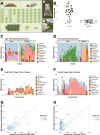Agricultural practices and pollinators modulate the anthosphere microbiome
- PMID: 40438189
- PMCID: PMC12118460
- DOI: 10.1093/ismeco/ycaf026
Agricultural practices and pollinators modulate the anthosphere microbiome
Abstract
The flower microbiome is pivotal in plant health, influencing reproductive success, fruit quality, and pathogen vulnerability. However, the impact of intensified agricultural practices on these microbial communities remains to be understood. This study examines how specific agricultural practices influence the bacterial composition of the strawberry anthosphere, focusing on cultivation intensification. Intensified systems were defined by practices such as indoor glasshouse substrate-based cultivation, increased use of plant protection products, larger cultivation areas, and reliance on managed pollinators. Using citizen science and V4 16S rRNA gene sequencing, we found that flowers in these more intensively managed systems had lower bacterial diversity, more variable microbiomes, and loss of core taxa such as Sphingomonas and Pseudomonas. To determine if pollinators could help mitigate these effects, we conducted exclusion experiments. In a tunnel system, we observed that foraging pollinators facilitated the dispersal of specific bacteria, such as Staphylococcus and Pseudomonas, and increased flower bacterial richness. However, in an open field, foraging pollinators had no significant impact. Our findings highlight the significant impact of cultivation intensification on the anthosphere microbiome and suggest that pollinators may play a role in restoring microbiome diversity. This research fills a critical gap in understanding how agricultural practices shape plant microbiomes and underscores the potential for microbe-based strategies to improve plant health in intensively managed systems.
Keywords: anthosphere; cultivation intensification; flower; microbiome; pollinator; strawberry.
© The Author(s) 2025. Published by Oxford University Press on behalf of the International Society for Microbial Ecology.
Conflict of interest statement
S.L. received funding from several probiotic companies that were not involved in this research. M.L. is part-time employed by Biobest Group NV, but this company was not involved in this research.
Figures




Similar articles
-
Pollinators mediate floral microbial diversity and microbial network under agrochemical disturbance.Mol Ecol. 2021 May;30(10):2235-2247. doi: 10.1111/mec.15890. Epub 2021 Apr 2. Mol Ecol. 2021. PMID: 33738885
-
Floral organs act as environmental filters and interact with pollinators to structure the yellow monkeyflower (Mimulus guttatus) floral microbiome.Mol Ecol. 2019 Dec;28(23):5155-5171. doi: 10.1111/mec.15280. Epub 2019 Nov 12. Mol Ecol. 2019. PMID: 31631452
-
Gazing into the anthosphere: considering how microbes influence floral evolution.New Phytol. 2019 Nov;224(3):1012-1020. doi: 10.1111/nph.16137. Epub 2019 Sep 25. New Phytol. 2019. PMID: 31442301 Review.
-
The role of foraging pollinators in assembling the flower microbiota and transmitting the fire blight pathogen Erwinia amylovora.Environ Microbiol. 2024 Oct;26(10):e16702. doi: 10.1111/1462-2920.16702. Environ Microbiol. 2024. PMID: 39389580
-
Endophytic bacteria: a sustainable strategy for enhancing medicinal plant cultivation and preserving microbial diversity.Front Microbiol. 2024 Nov 18;15:1477465. doi: 10.3389/fmicb.2024.1477465. eCollection 2024. Front Microbiol. 2024. PMID: 39624715 Free PMC article. Review.
References
-
- Morella NM, Zhang X, Koskella B. Tomato seed-associated bacteria confer protection of seedlings against foliar disease caused by pseudomonas syringae. Phytobiomes J 2019;3:177–90. 10.1094/PBIOMES-01-19-0007-R - DOI
LinkOut - more resources
Full Text Sources
Miscellaneous

